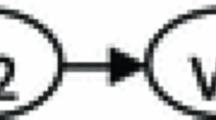Abstract
In this paper, we investigate the synchronization control of multiple autonomous underwater vehicles (AUVs), considering both state feedback and output feedback cases. Treating multiple AUVs as a graph, we define the tracking error of each AUV with both its own tracking error and the relative position errors with respect to its neighbors taken into account. Lyapunov analysis is used to derive the control law for each AUV. For the output feedback case, a passive filter is used to compensate for the unknown relative velocity errors among AUVs, and an observer is employed to estimate the velocity of the AUV itself. Rigid mathematical proof is provided for the proposed algorithms for both state feedback and output feedback cases. Simulations are provided to demonstrate the effectiveness of the proposed approach. It is shown that, the synchronization error is smaller in the case of considering the relative errors between AUVs than in the case of considering the tracking error of the single AUV only.
Similar content being viewed by others
References
Fossen T I. Guidance and Control of Ocean Vehicles. New York: Wiley Interscience, 1994
Skjetne R, Moi S, Fossen T. Nonlinear formation control of marine craft. In: Proceedings of IEEE Conference on Decision and Control, Las Vegas, 2002. 1699–1704
Stilwell D J, Bishop B E. Platoons of underwater vehicles. IEEE Contr System Mag, 2000, 20: 45–52
Fiorelli E, Leonard N, Bhatta P, et al. Multi-AUV control and adaptive sampling in Monterey Bay. IEEE J Oceanic Engin, 2006, 31: 935–948
Li Z, Tao P Y, Ge S S, et al. Robust adaptive control of cooperating mobile manipulators with relative motion. IEEE Trans Syst Man Cybern Part B Cybern, 2009, 39: 103–116
Li Z, Li J, Kang Y. Adaptive robust coordinated control of multiple mobile manipulators interacting with rigid environments. Automatic, 2010, 40: 2028–2034
Wang N, Zhang TW, Xu J Q. Formation control for networked spacecraft in deep space: with or without communication delays and with switching topology. Sci China Inf Sci, 2011, 54: 469–481
Cui R, Gao B, Guo J. Pareto-optimal coordination of multiple robots with safety guarantees. Auton Robots, 2012, 32: 189–205
Ge S S, Fua C H. Queues and artificial potential trenches for multirobot formations. IEEE Trans Robot, 2004, 21: 646–656
Cui R. Synchronized altitude tracking control of multiple unmanned helicopters. In: Proceedings of the 2010 American Control Conference, Baltimore, 2010. 4433–4438
Ma H B. Decentralized adaptive synchronization of a stochastic discrete-time multiagent dynamic model. SIAM J Contr Optimiz, 2009, 48: 859–880
Wu J, Shi Y. Consensus in multi-agent systems with random delays governed by a markov chain. Syst Contr Lett, 2011, 60: 863–870
Ren W. Multi-vehicle consensus with a time-varying reference state. Syst Contr Lett, 2007, 56: 474–483
Olfati-Saber R. Flocking for multi-agent dynamic systems: algorithms and theory. IEEE Trans Autom Contr, 2006, 51: 401–420
Ren W. Distributed leaderless consensus algorithms for networked Euler-Lagrange systems. Int J Contr, 2009, 82: 2137–2149
Aguiar P, Pascoal A M. Dynamic positioning and way-point tracking of underactuated AUVs in the presence of ocean currents. Int J Contr, 2007, 80: 1092–1108
Yang C. Output feedback NN control for two classes of discrete-time systems with unknown control directions in a unified approach. IEEE Trans Neur Netw, 2008, 19: 1873–1886
Yang C, Ge S S, Lee T H. Output feedback adaptive control of a class of nonlinear discrete-time systems with unknown control directions. Automat, 2009, 45: 270–276
Chen M. Adaptive tracking control of uncertain MIMO nonlinear systems with input constraints. Automat, 2011, 47: 452–465
Chen M, Ge S S, How B. Robust adaptive neural network control for a class of uncertain MIMO nonlinear systems with input nonlinearities. IEEE Trans Neur Netw, 2011, 21: 796–812
Edwards D, Bean T, Odell D, et al. A leader-follower algorithm for multiple AUV formations. In: Proceedings of IEEE/OES Autonomous Underwater Vehicles, Sebasco Estates, 2004. 40–46
Cui R, Ge S S, How V E B, et al. Leader-follower formation control of underactuated autonomous underwater vehicles. Ocean Engin, 2010, 37: 1491–1502
Ihle I A F, Jouffroy J, Fossen T I. Formation control of marine surface craft: a Lagrangian approach. IEEE J Ocean Engin, 2006, 31: 922–934
Rodriguez-Angeles A, Nijmeijer H. Mutual synchronization of robots via estimated state feedback: A cooperative approach. IEEE Trans Contr Syst Tech, 2004, 12: 542–554
Lizarralde F, Wen J T. Attitude control without angular velocity measurement: A passivity approach. IEEE Trans Autom Contr, 2002, 41: 468–472
Dong W, Guo Y. Global time-varying stabilization of underactuated surface vessel. IEEE Trans Autom Contr, 2005, 50: 859–864
Li Z, Cao X, Ding N. Adaptive fuzzy control for synchronization of nonlinear teleoperators with stochastic time-varying communication delays. IEEE Trans Fuzzy Syst, 2011, 19: 745–757.
Shi Y, Fang H, Yan M. Kalman filter-based adaptive control for networked systems with unknown parameters and randomly missing outputs. Int J Robust Nonlin Contr, 2009, 19: 1976–1992
Shi Y, Yu B. Robust mixed H 2/H ∞ control of networked control systems with random time delays in both forward and backward communication links. Automatic, 2011, 47: 754–760
Author information
Authors and Affiliations
Corresponding author
Rights and permissions
About this article
Cite this article
Cui, R., Yan, W. & Xu, D. Synchronization of multiple autonomous underwater vehicles without velocity measurements. Sci. China Inf. Sci. 55, 1693–1703 (2012). https://doi.org/10.1007/s11432-012-4579-6
Received:
Accepted:
Published:
Issue Date:
DOI: https://doi.org/10.1007/s11432-012-4579-6




